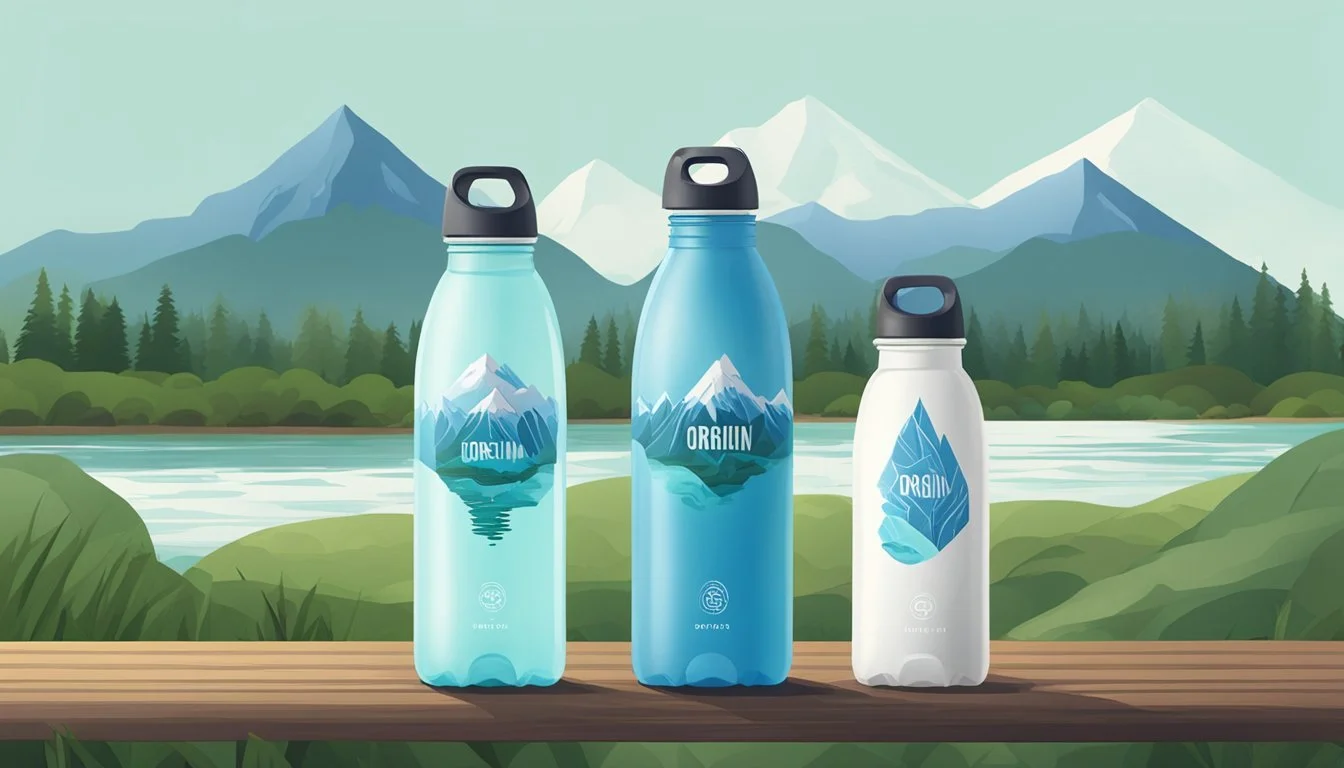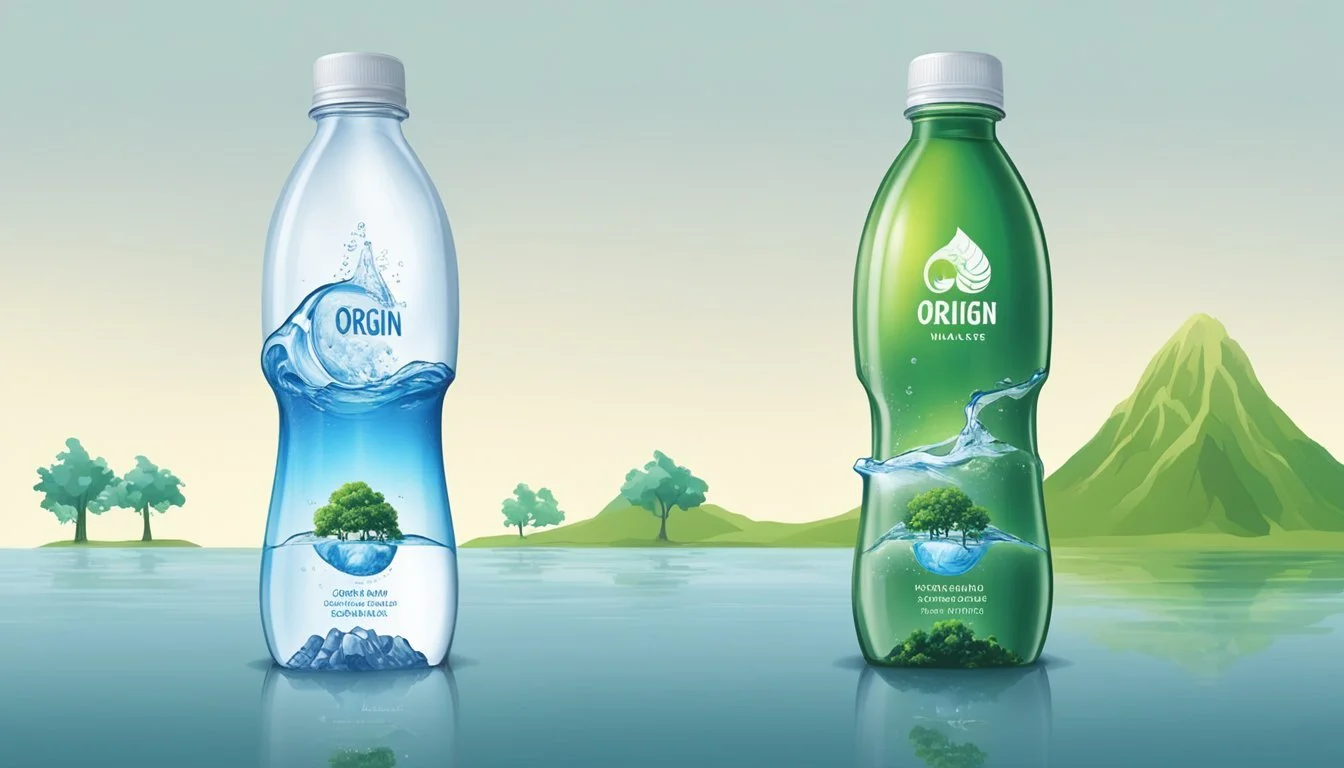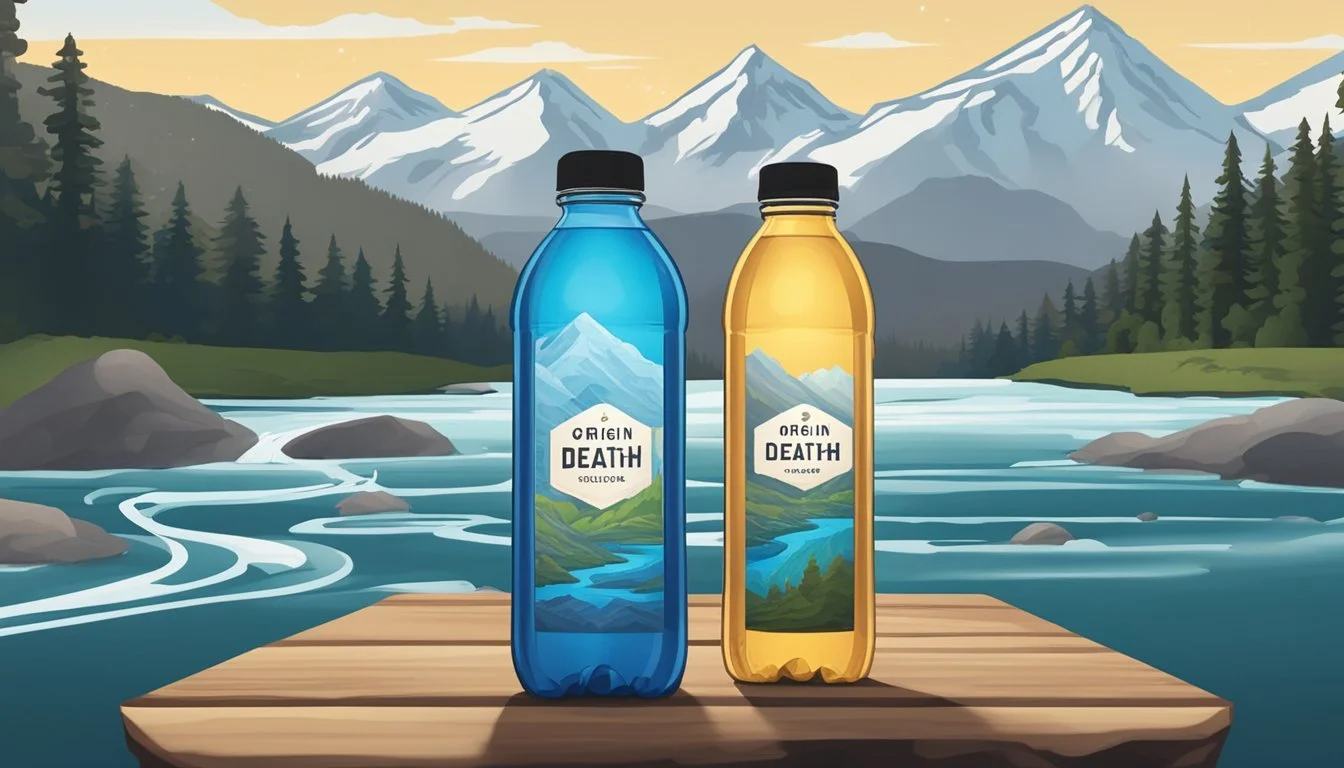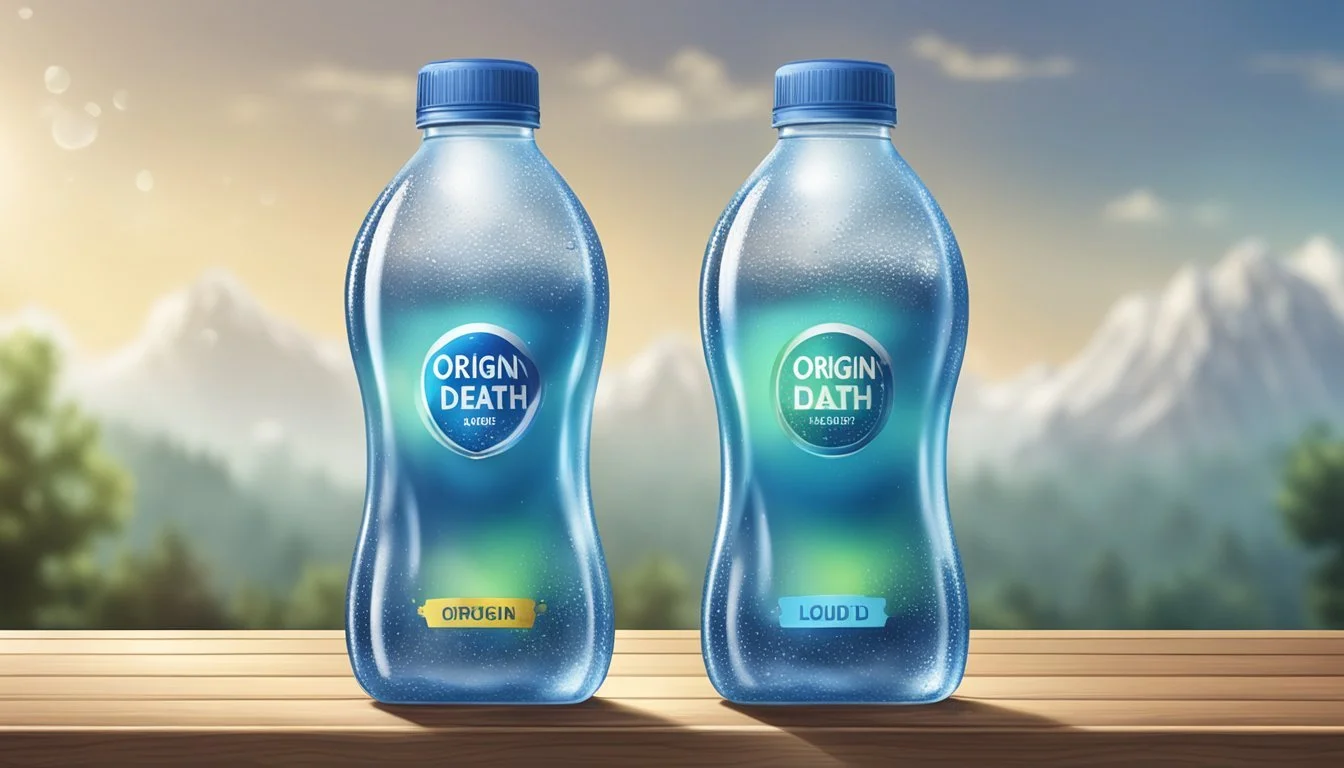Origin vs. Liquid Death
The Ultimate Bottled Water Showdown
Choosing the right bottled water can be important for those who prioritize hydration and sustainability. Origin and Liquid Death are two prominent brands in the market, each offering unique attributes that cater to different consumer preferences. While Origin provides a classic bottled water experience, Liquid Death stands out with its eco-friendly aluminum cans.
Origin, known for its purity and crisp taste, appeals to traditional bottled water enthusiasts who value straightforward hydration. On the other hand, Liquid Death has disrupted the market by packaging water in recyclable aluminum cans, appealing to environmentally-conscious consumers. The brand's edgy marketing and commitment to reducing plastic waste have garnered significant attention.
When it comes to consumer trends, Liquid Death's innovative approach and sustainability focus can give it an edge over Origin. Both brands offer high-quality water, but Liquid Death's environmental benefits and unique branding make it a compelling choice for modern consumers. This article will explore the differences between these two brands to help you decide which one is better for your lifestyle and values.
Understanding Bottled Water
The bottled water industry has evolved significantly over the years with various types of water available to cater to diverse consumer preferences. These changes have influenced global sales and market shares for different water brands.
Brief History and Market Evolution
Bottled water has been consumed for centuries, initially valued for its health benefits and mineral content. Early adopters often sought spring water reputed for its purity.
By the late 20th century, bottled water became a mainstream product, driven by health-conscious consumers and innovations like disposable plastic bottles. Brands such as Evian, Perrier, and Dasani emerged as household names, capturing significant market share.
In recent years, the focus has shifted towards eco-friendly packaging and sustainable sourcing, as seen with brands like Liquid Death that use recyclable aluminum cans instead of plastic bottles.
Types of Bottled Water
Several types of bottled water are available, each with unique properties:
Spring Water: Sourced directly from natural springs, often containing minerals that enhance taste and health benefits.
Mineral Water: Rich in minerals like calcium and magnesium, sourced from mineral springs and regulated for consistent mineral content.
Purified Water: Often derived from municipal sources and treated to remove impurities, making it ideal for those seeking clean, safe drinking water.
Sparkling Water: Carbonated and fizzy, available in various flavors and popular among those seeking an alternative to sugary beverages.
These types cater to varying consumer trends, from health-conscious individuals to those prioritizing sustainability. The diversity in offerings ensures that there's a suitable option for every preference.
Brand Analysis: Origin
Origin positions itself as a brand focused on providing high-quality natural spring water, emphasizing eco-friendly packaging and sustainability. Their product range includes various bottled water options that cater to different consumer preferences.
Brand Philosophy and Ethos
Origin prides itself on its environmentally conscious approach. The company places a strong emphasis on sustainability, aiming to minimize its carbon footprint through the use of recyclable materials.
The brand’s ethos revolves around providing pure, natural spring water sourced responsibly. They focus on transparency, often sharing detailed information about their water sources and production methods.
Eco-friendly practices are at the core of Origin’s brand philosophy. They advocate for better packaging solutions, emphasizing the use of recyclable materials to reduce environmental impact. By prioritizing sustainability, Origin appeals to consumers who are concerned with environmental issues and seek to support responsible brands.
Product Range and Offerings
Origin offers a diverse range of bottled water products. These include natural spring water available in various bottle sizes, from single-serving options to larger, multi-use bottles.
The packaging is designed to be practical yet environmentally friendly.
In addition to plain natural spring water, Origin's product line may also include flavored waters to cater to different tastes. This variety ensures that there is an option for everyone, whether they prefer pure water or something with a bit of flavor.
Through its product offerings, Origin continues to emphasize quality and sustainability, aiming to meet the needs of a wide range of consumers.
Brand Analysis: Liquid Death
Liquid Death has made a name for itself with its unique branding and bold marketing strategies. This section covers the brand's origins, marketing presence, and product innovations, giving readers insight into what makes Liquid Death stand out in the crowded bottled water market.
Origins and Brand Story
Liquid Death was created by Mike Cessario, a former creative director for Netflix. Cessario launched the brand to challenge traditional bottled water with a punk-rock ethos.
"Death to Plastic" became a core mission of the brand, aiming to eliminate plastic bottles by using infinitely recyclable aluminum cans. The brand's tagline, "Murder Your Thirst," encapsulates its rebellious and edgy approach.
The use of canned water—both flat and sparkling—sets Liquid Death apart, emphasizing environmental sustainability with its packaging.
Marketing and Social Media Presence
Liquid Death's marketing is known for its shock value and irony. The brand adopts a bold and often humorous tone to engage consumers, making use of unconventional advertising tactics.
They have a strong presence on platforms like Instagram, Facebook, and TikTok, where they share eye-catching and often meme-worthy content.
The brand's campaigns often highlight their mission to combat plastic waste, resonating with environmentally conscious consumers. Collaborations with influencers and events further enhance their visibility.
Product Innovation
Liquid Death doesn't just rely on its striking branding; its product offerings are equally innovative. They provide both still and sparkling water options in aluminum cans that are infinitely recyclable.
The sleek, minimalistic design of the cans enhances their appeal among younger, environmentally aware consumers.
Their distribution network includes major retail locations like Kroger and Target, along with online availability on Amazon and their own website. This widespread availability makes it easy for consumers to access their products.
These product choices, combined with eco-friendly packaging, underline Liquid Death’s commitment to innovation and sustainability in the beverage industry.
Packaging and Environmental Impact
Liquid Death and Origin differ significantly in their packaging approaches, with implications for environmental friendliness and carbon footprint.
Assessing Material Choices
Liquid Death uses recyclable aluminum cans, which are infinitely recyclable and require less energy to produce compared to plastic bottles. Aluminum production generally emits lower carbon dioxide levels than plastic.
In contrast, Origin typically uses plastic water bottles. While some plastic bottles are recyclable, the recycling rate for plastic is lower, and the process itself is more energy-intensive. Moreover, plastic bottles have a higher carbon footprint, releasing significant amounts of CO2 during production.
Choosing Liquid Death over Origin might lead to a more eco-friendly option due to the better packaging material. The use of aluminum cans contributes to waste reduction and lower environmental impact.
Consumer Experience
When comparing Origin and Liquid Death, consumer experience hinges on factors like taste, refreshment factor, and retail availability. These elements greatly influence preferences and purchasing decisions among consumers.
Taste and Refreshment Factor
Origin is known for its crisp, clean taste, often described as remarkably pure. The water is sourced from natural springs and undergoes minimal processing to retain natural minerals.
Liquid Death offers both flat and sparkling water options. The flat version is smooth and refreshing, while the sparkling version has a balanced level of carbonation that enhances its crispness without being overwhelming.
Consumers often cite the slight tang in Liquid Death's sparkling water as unique. Both brands ensure excellent hydration, but the availability of sparkling water gives Liquid Death an edge for those who prefer a fizzy experience.
Availability and Retail Distribution
Liquid Death has a significant presence in the market, available in over 113,000 retail outlets globally. Major retailers like Amazon, Whole Foods, 7-Eleven, and Publix stock this brand, making it highly accessible.
Consumers can purchase it individually or in packs, catering to various consumption needs.
Origin water is also widely distributed but predominantly found in health-focused and upscale retailers. While not as ubiquitous as Liquid Death in convenience stores, it maintains a strong presence in niche markets.
Both brands ensure ease of purchase through online platforms and brick-and-mortar stores, providing flexibility for consumers looking for convenience and immediate availability.
Cultural and Social Influence
Liquid Death and Origin have both captured the public's attention through unique cultural and social strategies. These practices involve high-profile endorsements, clever partnerships, and deep integration in lifestyle and entertainment sectors.
Endorsements and Partnerships
Liquid Death has effectively leveraged endorsements from influencers and celebrities. Travis Barker, a renowned drummer, is among the notable figures supporting the brand. Such partnerships boost visibility and credibility.
Live Nation, a giant in live entertainment, collaborates with Liquid Death, offering the drink at various events, expanding its influence among live entertainment-goers.
Origin, meanwhile, remains more traditional, depending on endorsements mainly within the wellness community. While it lacks the punk rock edge, it focuses on health-conscious figures, tapping into an audience seeking nonalcoholic, health-friendly beverages.
Ingraining in Lifestyle and Entertainment
Liquid Death has ingrained itself into lifestyle markets, especially by appealing to the punk and alternative scenes. Their branding, reminiscent of a punk album cover, and availability at bars, make the product a staple in social settings that typically feature alcoholic beverages.
Their marketing taps into the nonalcoholic drink market, targeting those who desire a bold beverage option without alcohol. The use of social media to push this image is crucial, creating viral content that cements its place in youth and alternative cultures.
Origin, though more subdued, promotes itself through wellness-focused events and forums, linking the brand to health and sustainability. This approach appeals to consumers who prioritize eco-friendly and health-conscious products.
Economic Perspective
Analyzing the economic impact involves understanding the cost efficiency and consumer value of Origin and Liquid Death bottled water. Each brand has its unique financial aspects and market presence.
Cost Efficiency and Consumer Value
Liquid Death, known for its distinctive brand, reported global sales of $263 million. Its use of aluminum cans offers a cost-effective and environmentally friendly solution, appealing to eco-conscious consumers. Initially, its marketing and brand identity may incur higher costs, yet the recyclable packaging can result in long-term savings.
Brand Material Environment Focus Initial Costs Long-term Savings Liquid Death Aluminum High High Moderate to High Origin Plastic Moderate Low to Moderate Lower
Origin offers a more affordable option with traditional plastic bottles. Its initial production costs are typically lower due to the widespread availability and manufacturing efficiency of plastic. However, the environmental impact might deter some consumers, potentially impacting its market share and long-term growth.
Market Share Impact: Both brands are navigating economic dynamics. Liquid Death's niche appeal and eco-friendly packaging may drive economic growth, while Origin's affordability could maintain a stable consumer base. By balancing cost and value, they carve distinct places in the market. This balance is crucial in determining their respective financial viabilities.
Final Comparison and Conclusion
Origin vs. Liquid Death
Packaging and Environmental Impact
When comparing Origin and Liquid Death on their environmental approach, it's evident that Liquid Death's use of recyclable aluminum cans stands out. Aluminum is infinitely recyclable and uses less energy compared to plastic.
Origin uses traditional plastic bottles which are a significant concern in terms of environmental sustainability.
Taste and Flavor Options
Liquid Death offers both sparkling and still water, with some flavored options. Their unique branding and can design give them a niche appeal. Origin, meanwhile, focuses on providing pure, high-quality still water with a clean taste, ideal for those preferring simplicity.
Market Presence and Popularity
Liquid Death has carved out a distinct market segment due to its edgy branding and eco-friendly packaging. It is available in various stores including 7-11 and Whole Foods. Origin, on the other hand, depends on its reputation for purity and quality, maintaining a solid market presence in bottled water.
Consumer Trends
Consumers looking for sustainable options are increasingly turning to Liquid Death for its aluminum cans. However, traditional preferences for plastic bottled water brands like Origin remain strong.
Price Comparison
Brand Price per Unit Origin $$ Liquid Death $
Each brand targets different consumer priorities, whether it's sustainability, taste, or purity.
Key Takeaways
Liquid Death: Eco-friendly, edgy, fizzy options
Origin: Traditional, pure, high-quality still water
Both brands have their unique appeals, catering to varied consumer needs and preferences in the bottled water market.
More About Origin
Mountain Valley Spring Water vs Origin: Which Bottled Water is Better?
Origin vs Kirkland Signature: Which Bottled Water is Better?
Origin vs Richard's Rainwater: Which Bottled Water is Better?
Origin vs Whole Foods Italian Still Mineral water: Which Bottled Water is Better?
More About Liquid Death
Aqua Carpatica vs Liquid Death: Which Bottled Water is Better?
Core Hydration vs Liquid Death: Which Bottled Water is Better?
Hawaii Volcanic vs Liquid Death: Which Bottled Water is Better?
Hawaiian Springs vs Liquid Death: Which Bottled Water is Better?
Ice Mountain vs Liquid Death: Which Bottled Water is Better?
Icelandic Glacial vs Liquid Death: Which Bottled Water is Better?
Liquid Death vs Cascade Mountain: Which Bottled Water is Better?
Liquid Death vs Crystal Geyser: Which Bottled Water is Better?
Liquid Death vs Crystal Lake: Which Bottled Water is Better?
Liquid Death vs Essence pH10: Which Bottled Water is Better?
Liquid Death vs Kirkland Signature: Which Bottled Water is Better?
Liquid Death vs Proud Source: Which Bottled Water is Better?
Liquid Death vs Richard's Rainwater: Which Bottled Water is Better?
Liquid Death vs Simple Truth: Which Bottled Water is Better?
Liquid Death vs Talking Rain AQA: Which Bottled Water is Better?
Liquid Death vs Whole Foods 365: Which Bottled Water is Better?
Liquid Death vs Whole Foods Italian Still Mineral water: Which Bottled Water is Better?
Mountain Valley Spring Water vs Liquid Death: Which Bottled Water is Better?
Nestle Pure Life vs Liquid Death: Which Bottled Water is Better?
Poland Spring vs Liquid Death: Which Bottled Water is Better?
Purely Sedona vs Liquid Death: Which Bottled Water is Better?
San Pellegrino vs Liquid Death: Which Bottled Water is Better?
Solan de Cabras vs Liquid Death: Which Bottled Water is Better?








